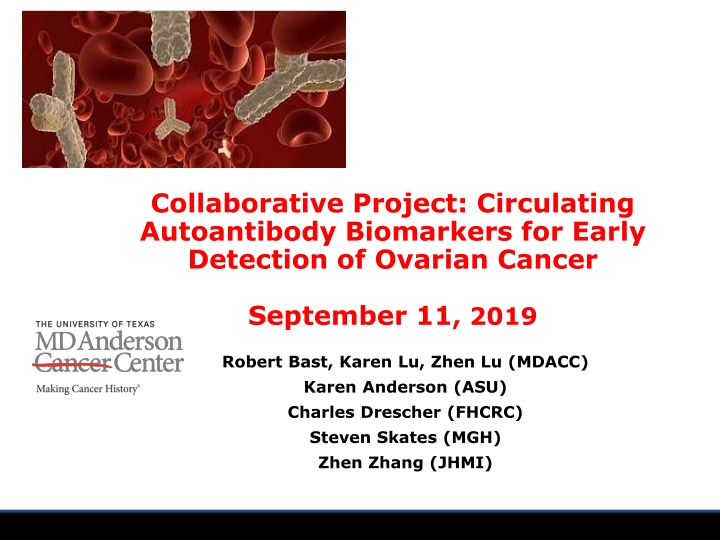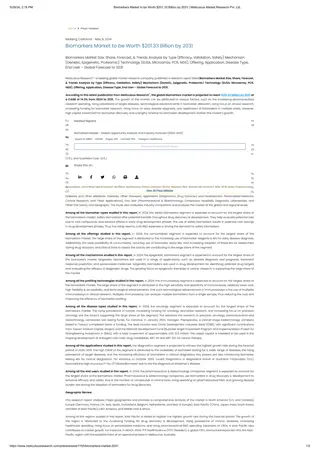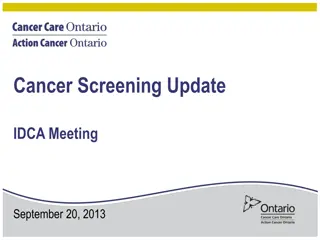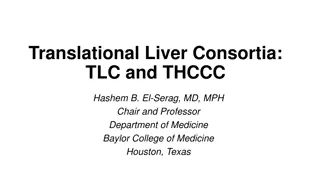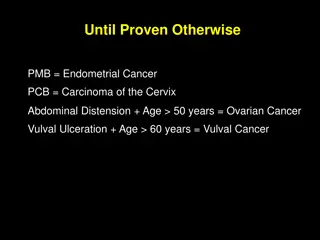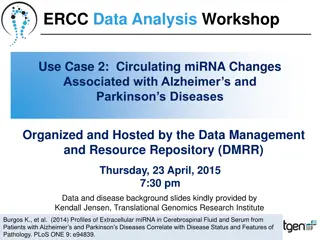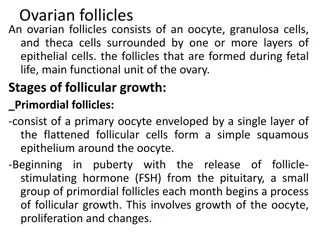Collaborative Project: Circulating Autoantibody Biomarkers for Early Detection of Ovarian Cancer
This collaborative project aims to utilize circulating autoantibody biomarkers for the early detection of ovarian cancer, highlighting the importance of screening due to the high curability rates in early stages and the need to improve survival rates by identifying preclinical disease sooner. The project emphasizes the significance of achieving high sensitivity and specificity in screening methods, including a two-stage strategy that has shown promise in detecting a larger fraction of early-stage diseases. Various key contributors and research findings in ovarian cancer screening are showcased, emphasizing the potential impact on mortality rates.
Download Presentation

Please find below an Image/Link to download the presentation.
The content on the website is provided AS IS for your information and personal use only. It may not be sold, licensed, or shared on other websites without obtaining consent from the author.If you encounter any issues during the download, it is possible that the publisher has removed the file from their server.
You are allowed to download the files provided on this website for personal or commercial use, subject to the condition that they are used lawfully. All files are the property of their respective owners.
The content on the website is provided AS IS for your information and personal use only. It may not be sold, licensed, or shared on other websites without obtaining consent from the author.
E N D
Presentation Transcript
Collaborative Project: Circulating Autoantibody Biomarkers for Early Detection of Ovarian Cancer September 11, 2019 of Ovarian Cancer Robert Bast, Karen Lu, Zhen Lu (MDACC) Karen Anderson (ASU) Charles Drescher (FHCRC) Steven Skates (MGH) Zhen Zhang (JHMI)
Rationale for Ovarian Cancer Screening Ovarian Cancer Limited to the Ovaries (Stage I) or to the Pelvis (Stage II) can be cured in 90% and 70% of Patients with Currently Available Therapy Disease that has Spread from the Pelvis (Stage III- IV) can be Cured in only 20% or Less Only 20% of Ovarian Cancers are Currently Diagnosed in Stage I or II Detection of Preclinical Disease at an Earlier Stage Could Improve Survival by 10-30%
Screening for Ovarian Cancer requires High Sensitivity and Very High Specificty Postmenopausal Prevalence: 1:2,500 High Sensitivity: 75% Very High Specificity: 99.6% Positive Predictive Value: 10%
A Two Stage Strategy can Achieve Adequate Specificity Neither CA125 nor Transvaginal Sonography is Adequately Specific A Two Stage Strategy where Rising CA125 triggers TVS and Abnormal TVS prompts Surgery has achieved Adequate Specificity In Two Major Screening Trials NROSS and UKCTOCS only 3-4 Operations have been required for Each Ovarian Cancer Diagnosed
A Two Stage Strategy can detect a Larger Fraction of Early Stage Disease While ~20% of Ovarian Cancers present in Stage I-II, 36% were detected in Early Stage in the UKCTOCS and 61% in the NROSS Screening Trials The UKCTOCS trial was Adequately Powered (200,000 Participants) to detect a decrease in Mortality Two Stage Screening missed Statistical Significance A Pre-specified Subset that excluded Prevalent Cases, showed a 20% Reduction in Mortality (P=0.021) Menon et al, J Clin Oncol, 2015, Jacobs, et al Lancet 2015
UKCTOCS Mortality Data Jacobs I, eta al, Lancet, 2015
Adequate Sensitivity is the Major Challenge for Early Detection of Ovarian Cancer Whatever the Outcome of the Reanalysis of the UKCTOCS, a Two Stage Strategy has solved the Problem of Specificity Improved Sensitivity is the Major Challenge for Both Stages: Biomarkers and Imaging Many Opportunities to Improve Sensitivity of the Initial Phase of Screening
Adequate Sensitivity is the Major Challenge for Early Detection of Ovarian Cancer Only 80% of ovarian cancers express significant levels of CA125. There is a need for additional marker(s) to detect early stage disease. Our goal is to develop a marker panel that detects at least 90% of early stage disease. We have evaluated 110 potential biomarkers. Addition of HE4 and CA72.4 detects 16% of cases missed by CA125, but does not provide lead time. A new algorithm is being developed with CA125, HE4 and CA72.4. Simmons, et al. Cancer Prevention Res, 2019
Serous Carcinoma Progression Model: Fimbriae of the Fallopian Tube Karst and Drapkin, 2010
Improving the Initial Stage in Screening Very small cancers that arise in fimbria of the fallopian tube could shed metastatic cancer cells into the peritoneal cavity. To obtain elevated levels of shed protein antigens in blood, a larger volume of cancer may be required. Autoantibodies against cancer associated proteins could be stimulated by very small cancers. All high grade serous cancers have TP53 mutations and autoantibody against TP53 have been reported by several groups
Anti-TP53 Autoantibodies increase earlier than CA125 7 Mos 8 Mos Yang et al, Clinical Cancer Res, 2017
Anti-TP53 Autoantibodies 21-26% of ovarian cancer patients with early and late stage disease have autoantibodies against TP53 in data sets from the US, Australia and the UK Titers of anti-TP53 autoantibodies increase 8 months before elevation of CA125 and 22 months prior to clinical presentation in patients who do not exhibit increases in serum CA125 Autoantibodies appear to recognize WT TP53, but are associated with TP53 mutations and overexpressed protein This is the first of >110 biomarkers tested that produces lead time over CA125 Yang et al, Clinical Cancer Res, 2017
Project 1: Measurement of Anti-TP53 Autoantibodies on Different Platforms Compare prospectively on Five Different Platforms Assemble Panel of 952 Sera including 250 Early and Late Stage Ovarian Cancer Cases enriched for High Grade Serous Cancers with TP53 mutations
Platforms to Measure TP53 Autoantibody in Serum Samples 1. Rapid Antigenic Protein In situ Display (RAPID) Cobas Luminex xMAP Luminex SeroMAP 2. Meso Scale Discovery (MSD)
Serum Sample Study Set Serum Samples Healthy Controls (n = 502) Benign Pelvic Masses (n = 200) Ovarian Cancer (n = 250) Institution Fred 369 144 122 Hutchinson MD Anderson 133 56 128 Sample randomization for blinded testing
TP53 Autoantibody using the Luminex xMAP Assay (MDACC) 78 U/mL Cut-off Total Cases Early Stage Late Stage Benign Control TP53 AAb (+) 7/70 26/180 33/250 1/200 10/502 Percentage 10.0 14.4 13.2 0.5 2.0
TP53 Autoantibody using the RAPID Assay (ASU) 4.3 ratio Cut-off Total Cases Early Stage Late Stage Benign Control TP53 AAb (+) 10/70 44/180 54/250 1/200 10/502 Percentage 14.3 24.4 21.6 0.5 2.0
p5TP53 Autoantibody using the MSD Assay (ASU) 105 ratio Cut-off Early Stage Total Cases Late Stage Benign Control TP53 AAb (+) 7/70 42/180 49/250 1/200 10/502 Percentage 10.0 23.3 19.6 0.5 2.0
pTP53 Autoantibody using the Luminex SeroMAP Assay (FHCRC) 98% Specificity Cut-off Total Cases Early Stage Late Stage Benign Control TP53 AAb (+) 8/70 37/180 45/250 2/200 10/502 Percentage 11.4 20.6 18.0 1.0 2.0
Sensitivity (%) of Four Assays at 98% Specificity Early Stage Late Stage Institute/ Platform Total Case Benign Control MDACC/xMAP 10.0 14.4 13.2 0.5 2.0 ASU/RAPID 14.3 24.4 21.6 0.5 2.0 ASU/MSD 10.0 23.3 19.6 0.5 2.0 2,0 FHCRC/SeroMAP 11.4 20.6 18.0 1.0
Project 1: Conclusions Four Assays yielded comparable sensitivities for early (10-14%) and late stage (14-24%) ovarian cancer Sensitivity for early stage disease was lower than anticipated (~20%) based on MDACC assays The ASU RAPID assay exhibited the greatest sensitivity Although statistically significant, correlation between pairs of the four assays was modest The Roche anti-TP53 assay will be available in October
Project 2: Evaluation and Validation of Multiple Autoantibody Candidates Evaluate 37 candidate autoantibodies and antigen- autoantibody complexes from the 3 collaborating institutions to establish a panel with CA125 that detects >90% of early stage cases with lead time over CA125 alone Initially use the same serum panel utilized for anti-TP53 and validate the most promising candidates with an independent panel 100 early stage 100 late stage 200 benign 1000 healthy controls
Project 2: Evaluation and Validation of Multiple Autoantibody Candidates Evaluate 37 candidate autoantibodies and antigen- autoantibody complexes from the 3 collaborating institutions to establish a panel with CA125 that detects >90% of early stage cases with lead time over CA125 alone Initially use the same serum panel utilized for anti-TP53 and validate the most promising candidates with an independent panel 100 early stage 100 late stage 200 benign 1000 healthy controls
Autoantibody Candidates In Early Stage (I-II) Ovarian Cancer, Anti-CTAG-1A (NYESO- 1) was positive in 11%, anti-CTAG 2 (ESO-2) in 11% and the Combination with Anti-TP53 in 36% A review of the world literature (Fortner, Gynecol Oncol, 2017) identified 12 autoantibodies that detected >20% of ovarian cancers. Only Anti-IL-8 could be replicated with Anti-IL-8 autoantibodies detecting 7% of Early Stage (I-II) Ovarian Cancers The Anti-IL-8 Autoantiboidies added Little to CA125, M-CSF and Osteopontin
OPN, MIF and IL-8 autoantibodies (Aab) complement CA125 for detection of early stage (I-II) ovarian cancer CA125 + OPN + MIF + IL-8 AAb detect 82% of early stage (I-II) Guo et al, Cancers, 2019
HE4 Complements CA125 for Detecting Early Stage Ovarian Cancer HE4, a whey acidic protein (WFDC2), previously called Human Epidydemal Protein 4, was discovered with monoclonal antibodies, but also found on expression arrays HE4 is less sensitive than CA 125 for detecting early stage ovarian cancer, but has better specificity for distinguishing malignant and benign pelvic masses A combination of CA125 and HE4 detects a greater fraction of early stage cancers than either alone Autoantibodies against HE4 and HE4 antigen- autoantibody complexes had not been previously evaluated in early stage (I-II) ovarian cancer
HE4 Antigen-Antibody Immune Complex Dissociation Serum sample (2 l) 0.1M Glycine- HCl pH3.0 in PBS (48 l) Dissociation Antigen Incubate for 30 min @ RT Zeba Spin Desalting Column (Life Technologies) Buffer exchange Antigen Immunoglobulins-dissociated serum sample
HE4 Antigen-antibody Complexes complement CA125 for Detection of Early Stage Ovarian Cancer 730 Case Control CA125+ HE4 Ag-Ab detect 80.3% of early stage cases HE4 Ag-Ab (+) 28/71 4/213 Percentage 39.4 1.8 Yang et al, Cancer, In press
Project 2: Conclusions Complementarity has been demonstrated with Anti- CTAG-1A, Anti-CTAG2 and Anti-TP53 detecting 36% of Early Stage (I-II) Ovarian Cancers Complementarity has also been observed between Anti- HE4 Antigen-Autoantibody Complexes and CA125, detecting 80% of Early Stage (I-II) Ovarian Cancers Thirty-seven Additional Autoantibodies will be Evaluated and the Most Promising Panel Validated with an Independent Set of 1,400 Sera
Acknowledgements MD Anderson Wei-Lei Yang, PhD Jing Guo, MD, MS Joseph Celestino Fred Hutchinson Cancer Center NCI EDRN Martin McIntosh, PhD CPRIT Sarah Hawley Lindsey Bergen Minnesota Ovarian NFCR Cancer Alliance
